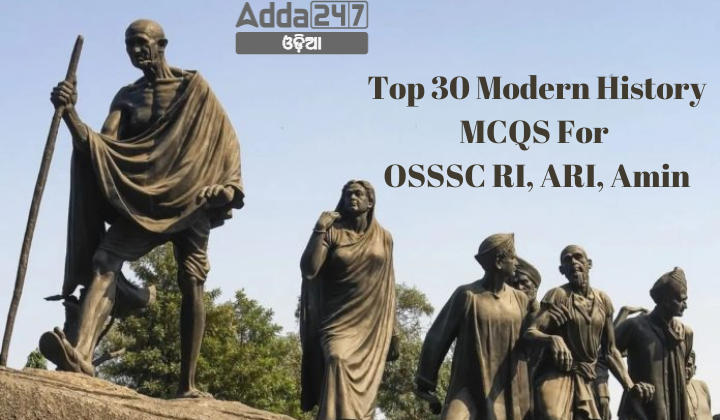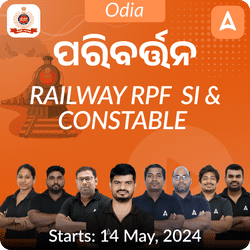Preparing for competitive exams such as OSSSC RI (Revenue Inspector), ARI (Assistant Revenue Inspector), Amin, SFS, or ICDS Supervisor often requires a strong grasp of historical events. Modern history, especially, forms a significant part of the syllabus, covering crucial periods and events that shaped the world as we know it today. To aid in your preparation, here are 30 multiple-choice questions (MCQs) focusing on modern history:
Top 30 Modern History MCQS For OSSSC RI, ARI, Amin, SFS, ICDS Supervisor
- Which document is often referred to as the Magna Carta of the Indian people?
A. The Government of India Act, 1858
B. The Ilbert Bill
C. Indian Councils Act of 1892
D. Queen Victoria’s Proclamation
Ans: D - How did early nationalists successfully challenge the moral authority of British rule?
A. By their agitation for Constitutional reforms
B. By advocating open revolt
C. By seeking foreign help against the British
D. By seeking the support of Indians living abroad
Ans: A - Which aims were pursued by the Indian National Congress in its early phases?
I. Eradication of all possible race, creed, or provincial prejudices among all lovers of India.
II. Promotion of personal intimacy among all earnest workers in the cause of India.
III. Formulation of popular demands.
IV. Organization of a violent struggle for the political emancipation of India.
A. I, II & III
B. II, III & IV
C. III & IV
D. I & II
Ans: A - Which newspaper was founded by Annie Besant?
A. The Hindu
B. Indian Express
C. The Times of India
D. New India
Ans: D - Who is considered the real founder of the Aligarh Muslim University?
A. Nawab Salimullah
B. Syed Ahmad Khan
C. Abul Kalam Azad
D. Muhammad Ali Jinnah
Ans: B - Which statement about the Government of India Act of 1919 is incorrect?
A. British India must remain an integral part of the British Empire.
B. Responsible government would be realized only by progressive stages.
C. Provincial subjects were classified into reserved subjects & transferred subjects.
D. The salary of the Secretary of State for India was drawn out of the revenues of the Indian government.
Ans: D - What event inspired the formation of the Home Rule Leagues in India?
A. First World War
B. Just before the First World War
C. After the First World War
D. After the passing of the Act of 1909
Ans: A - Which leader was not associated with the extremist leadership of the Indian National Congress?
A. Lokmanya Tilak
B. Aurobindo Ghosh
C. Lala Lajpat Rai
D. A. O. Hume
Ans: D - Which provision was included in the Government of India Act of 1919?
A. Transfer of power to the Indians
B. The enlargement of the Viceroy’s Executive Council
C. Remodeling of the Central legislature
D. Doing away with the distinction between the regulation and non-regulation provinces
Ans: A - When was the famous Resolution on non-cooperation, inspired by Mahatma Gandhi, adopted in a special session of the Congress held in Calcutta?
A. September, 1920
B. December, 1922
C. October, 1924
D. November, 1925
Ans: A - Which of the following leaders organized the Swaraj Party?
A. Lala Lajpat Rai and Feroz Shah Mehta
B. Sarojini Naidu and Annie Besant
C. C. R. Das and Motilal Nehru
D. C. Rajagopalachari and C. Y. Chintamani
Answer: C. C. R. Das and Motilal Nehru - Why was the Khilafat Movement started?
A. To protest against the injustice done to Egypt
B. To protest against the injustice done to Arabia
C. To protest against the injustice done to Persia
D. To protest against the injustice done to Turkey
Answer: D. To protest against the injustice done to Turkey - Where did Gandhiji form the Satyagarh Sabha?
A. Bombay
B. Calcutta
C. Poona
D. Nagpur
Answer: A. Bombay - Which of the following is not correctly matched?
A. Bhagat Singh: Meerut Conspiracy Case
B. Ram Prasad Bismil: Kakori Conspiracy Case
C. Chandra Shekhar Azad: New Delhi Conspiracy
D. Surya Sen: Chittagong Armoury Raid
Answer: C. Chandra Shekhar Azad: New Delhi Conspiracy - Which event was the reason for suspension of the Non-Cooperation Movement?
A. The non-Cooperators were not enthusiastic
B. The leaders like Subhas Chandra Bose were against it
C. Gandhiji bowed to the pressure of the British government
D. Chauri Chaura incident
Answer: D. Chauri Chaura incident - Which trio of leaders were referred to as Lal, Bal, and Pal during the freedom movement?
A. Lala Lajpat Rai, Bal Gangadhar Tilak, and Bipin Chandra Pal
B. Lal Bahadur Shastri, Bal Gangadhar Tilak, and Bipin Chandra Pal
C. Lal Bahadur Shastri, Bal Gangadhar Tilak, and Gopala Krishna Gokhale
D. Lala Lajpat Rai, Bal Gangadhar Tilak, and C. Rajagopalachari
Answer: A. Lala Lajpat Rai, Bal Gangadhar Tilak, and Bipin Chandra Pal - Which incident ended the historic fast of Gandhi?
A. Poona Pact
B. Issue of White Paper
C. Gandhi-Irwin Pact
D. Arrival of Simon Commission
Answer: A. Poona Pact - Consider the following statements related to the Nehru Report:
I. It favoured Dominion Status.
II. It favoured a federal system.
III. It rejected the system of Communal Electorate.
IV. It was against the setting up of a Supreme Court.
Which of the above statement(s) is/are correct?
A. I & IV
B. I & III
C. II, III & IV
D. I, II & III
Answer: D. I, II & III - Select the correct chronological sequence of the following events:
I. Appointment of the Simon Commission.
II. Formation of the first Labour Government in Britain.
III. Submission of the Nehru Report.
IV. Inauguration of the First Round Table Conference.
Select the correct answer from the codes given below:
A. I, III, II & IV
B. I, III, IV & II
C. I, II, IV & III
D. II, IV, I & III
Answer: A. I, III, II & IV - Who led the Bardoli Satyagraha in 1928?
A. Morarji Desai
B. M. K. Gandhi
C. Mahadev Desai
D. Vallabhbhai Patel
Answer: D. Vallabhbhai Patel - Why was the Simon Commission boycotted?
A. Simon was not known to be a great supporter of the Indian cause.
B. All the members of the commission were Englishmen.
C. It was appointed before the expiry of the statutory period.
D. Peaceful demonstrators were severely beaten by the police.
Ans: B. All the members of the commission were Englishmen. - What was the Ilbert Bill intended for?
A. To remove racial discrimination in employment
B. To enable India District Magistrates and Session Judges to try Europeans
C. To save Indians from racial humiliation
D. To change the method of recruitment in the Indian Civil Servic
Ans: B. To enable India District Magistrates and Session Judges to try Europeans - Which of the following statements about the Government of India Act of 1935 is not correct?
A. Diarchy was established in the provinces.
B. The Viceroy was given special powers.
C. The federal executive was to consist of the Viceroy, councillors and the ministers.
D. The federal legislature was to be bicameral.
Ans: A. Diarchy was established in the provinces. - Which leader said that the Act of 1935 provided ‘a machine with strong brakes but no engine’?
A. Jawaharlal Nehru
B. Rajendra Prasad
C. Mahatma Gandhi
D. Vallabhbhai Patel
Ans: A. Jawaharlal Nehru - The Battle of Wandiwash was fought between:
A. The Nizam of Hyderabad and the French
B. The English and the French
C. The English and Hyder Ali
D. The Nawab of Carnatic and the English
Ans: B. The English and the French - Which Congress leader rejected the ‘August Offer’ of 1940?
A. Lord Wavell
B. Lord Linlithgow
C. Sir George Stanley
D. Lord Willingdon
Ans: B. Lord Linlithgow - Which event compelled Rabindranath Tagore to renounce his knighthood?
A. To protest against the Jallianwalla Bagh incident
B. To protest against lathi charge on Lala Lajpat Rai that caused his death
C. To express solidarity with the leaders of Non-Cooperation Movement
D. To express solidarity with the protestors against the arrival of Simon Commission
Ans: A. To protest against the Jallianwalla Bagh incident - Which British official initiated the Doctrine of Lapse?
A. Lord Wellesley
B. Lord Auckland
C. Lord Dalhousie
D. Warren Hastings
Ans: C. Lord Dalhousie - Who was the counterpart of the British in the Treaty of Salbai?
A. the French
B. the Marathas
C. Tipu Sultan
D. the Nizam of Hyderabad
Ans: B. the Marathas - Which treaty ended the First Carnatic War?
A. Salbai
B. Bassein
C. Aix-la-Chapelle
D. Paris
Ans: C. Aix-la-Chapelle
















